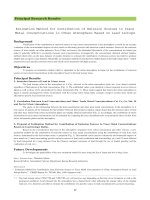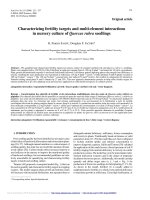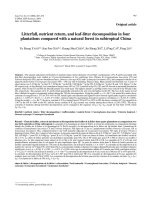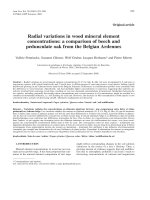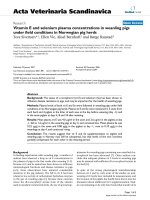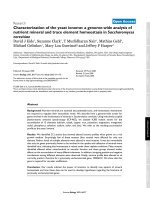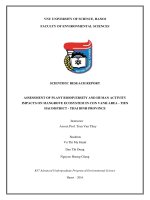Depth profiles of δ13c and trace element concentrations in mangrove ecosystem of tien hai natural reserve, vietnam
Bạn đang xem bản rút gọn của tài liệu. Xem và tải ngay bản đầy đủ của tài liệu tại đây (456.64 KB, 8 trang )
Interdisciplinary Studies on Environmental Chemistry—Environmental Pollution and Ecotoxicology,
Eds., M. Kawaguchi, K. Misaki, H. Sato, T. Yokokawa, T. Itai, T. M. Nguyen, J. Ono
and S. Tanabe, pp. 463–470.
© by TERRAPUB, 2012.
Depth Profiles of δ 13C and Trace Element Concentrations in
Mangrove Ecosystem of Tien Hai Natural Reserve, Vietnam
Nguyen Tai TUE1,2, Tran Dang QUY 3, Hideki H AMAOKA1, Luu Viet D UNG2,
Mai Trong NHUAN3 and Koji OMORI1
1
Center for Marine Environmental Studies (CMES), Ehime University,
2-5 Bunkyo-cho, Matsuyama, Japan
2
Graduate School of Science and Engineering, Ehime University,
2-5 Bunkyo-cho, Matsuyama, Japan
3
Faculty of Geology, College of Science, Vietnam National University,
334 Nguyen Trai str., Hanoi, Vietnam
(Received 29 September 2011; accepted 4 November 2011)
Abstract—The objectives of present study are to examine the sources of
sedimentary organic carbon (SOC) and depth profiles of 12 trace element
concentrations (V, Cr, Mn, Co, Cu, Pb, Zn, Mo, Ag, Cd, Sn, and Sb) in a
sediment core from mangrove forest of Tien Hai Natural Reserve, Vietnam.
The profiles of δ13C and C/N ratio demonstrated that the SOC originated from
a mixture of mangrove litters and marine phytoplankton. The relative
contribution of mangrove litters ranged from 35.3 to 75.1%, with an average of
49.6%, and gradually increased from the core bottom to surface sediment. The
trace elements V, Cr, Mn, Co, Cu, Pb, Zn, Sn, and Sb concentrations increased
from core bottom to 50 cm of depth, and then slightly varied to surface
sediment. The trace elements Mo, Ag, and Cd concentrations slightly increased
between core bottom and 11 cm of depth, and then decreased to surface
sediment. The PCA results illustrated that the trace elements from industrial
sources have probably impacted on the Tien Hai mangrove area in a long-term,
and the high levels of TOC and fine sediment grain sizes were the major
mechanisms of trace element absorptions in mangrove sediments.
Keywords: carbon stable isotope, C/N ratio, mangrove, trace elements, sediment
core, Tien Hai Nature Reserve
INTRODUCTION
Mangrove ecosystems have high net primary production. As a result, they are
considered to be an important sink of organic carbon. Mangrove organic carbon
is stored in the above-belowground biomass and sediments. Sedimentary organic
carbon (SOC) is composed of autochthonous mangrove plants and allochthonous
sources (e.g., terrestrial organic matter and marine phytoplankton). The SOC has
been recognized as one of important factor composing the carbon budget of
mangrove ecosystems. However, the sources of SOC have rarely been described
in detail.
463
464
N. T. T UE et al.
Mangrove sediments are generally homogeneous in texture and rich in
organic matter. They act as effective sinks of pollutants (i.e., trace elements)
through tidal cycles and river outflows. From the sediment-water interface, trace
elements can be transferred into mangrove plants (MacFarlane et al., 2003) and
benthic organisms (Saha et al., 2006). Subsequently, they accumulated into
higher trophic levels of animals in the local food webs (Jara-Marini et al., 2009).
Therefore, the mangrove sediments may shift from sink to source of trace
elements in the coastal water systems (Harbison, 1986). The information of trace
element concentrations in mangrove sediments is needed to assess the toxicological
effects for benthic animals and to evaluate the functioning of mangrove ecosystems
in the filtering and containment of terrestrial-derived pollutants.
In this study, carbon stable isotope (δ13C), total organic carbon (TOC),
atomic C/N ratios, and 12 trace element concentrations (V, Cr, Mn, Co, Cu, Pb,
Zn, Mo, Ag, Cd, Sn, and Sb) were analyzed in a sediment core in order to (1)
examine the sources of SOC, and (2) determine the trace element concentration
profiles in a mangrove ecosystem from Vietnam.
MATERIALS AND METHODS
Study area
The present work was conducted in an estuarine mangrove ecosystem of
Tien Hai Nature Reserve (THNR) in northern Vietnam (Fig. 1). Tien Hai Natural
Reserve (THNR) is located in the northern part of the Ba Lat Estuary, Red River,
which is the largest river in northern Vietnam. The THNR covers a total wetland
area of 12,500 ha, of which about 3,000 ha is covered by mangrove forests. The
mangrove species, including Kandelia obovata, Sonneratia caseolaris, and
Aegiceras corniculatum are predominant. They provide great ecological and
economical values, for example they are essential nursery grounds for many
species of fishes, invertebrates, and waterfowl. However, there still remains a
major deficiency of information on sources of SOC and trace element
concentrations.
Field sampling
The fieldwork was conducted from 2–10 February, 2008 during low tide in
the mangrove forest of THNR, Vietnam (Fig. 1). Sediment core (75 cm in length)
was taken by a hand corer with a PVC inner tube (1.5 m in length and 10 cm in
diameter). The sediment core located at position (20°17′39″ N; 106°36′6″ E). It
was assigned as core TH-01, and immediately capped, and maintained cool. It
was processed within 12 hours of collection by first removing the outer layers (0.5
cm in thickness) and then slicing into 1 cm interval by a plastic knife. Sediment
sections were packed in labeled polyethylene bags for further analysis. A part of
sediment sample was also placed in a plastic cube (1 cm3) for porosity analysis.
Samples were immediately stored in iceboxes and transported to the laboratory
where they were frozen at –20°C until further processing and analysis.
Trace Element and δ 13C Profiles in a Mangrove Ecosystem from Vietnam
465
Fig. 1. Sampling sites showing location of sediment core TH-01 within mangrove forest from the
Tien Hai Natural Reserve, Vietnam.
Sample analysis
Sediment samples were dried at 60°C for 48 hours in an electric oven and
subsequently pulverized using a mortar and pestle. Sediment grain size (Mdϕ)
was measured by using a laser diffraction particle size analyzer (SALD-2100,
Shimadzu Co.) according to the procedure described by Amano et al. (2006). The
porosity measurement has been described elsewhere (Tue et al., 2011a).
For δ 13C, TOC, and C/N ratio analysis, sediment samples were processed
following the methods of Tue et al. (2011a). δ 13C, TOC, and C/N ratios were
analyzed by using a stable isotope mass spectrometer (ANCA-SL, PDZ Europa,
Ltd.). The δ13C was expressed in ‰ (per mil) deviations from the standard value
by the following equation (1):
Rsample
δ 13C( ‰ ) =
− 1 × 1000
Rstandard
where R =
13
(1)
C/12C, Rsample is the isotope ratio of the sample, and Rstandard is the
466
N. T. T UE et al.
Fig. 2. Depth profiles of sedimentary parameters of sediment core TH-01. Mdϕ is sediment grain
sizes ( µm).
isotope ratio of a standard referenced to Pee Dee Belemnite (PDB) limestone
carbonate. The analytical error was ±0.1‰ for δ13C.
The procedure used for measuring trace element concentrations has been
previously described (Tue et al., 2011b). Concentrations of 12 trace elements (V,
Cr, Mn, Co, Cu, Pb, Zn, Mo, Ag, Cd, Sn, and Sb) were analyzed with an
inductively coupled plasma-mass spectrometer (ICP-MS, HP-4500, Avondale,
PA, USA) with rhodium as the internal standard. Accuracy and precision of the
methods were assessed using the certified marine sediment reference material
PACS-2 (National Research Council Canada), and recoveries of all the trace
elements ranged from 89.3 to 111.6% of the certified values (Tue et al., 2011b).
In addition, triplicate analyses were applied for each sediment sample, and the
concentrations of trace elements were displayed by the average values. One half
of the value of the respective limits was substituted for those values below the
limit of detection.
RESULTS AND DISCUSSION
Sediment characteristics
The sediments of core TH-01 were muddy, and colors were reddish brown,
light olivine brown, and grayish brown. They were homogeneous and rich in
organic matter. The Mdϕ varied between 5.9 and 15 µm, with an average value
of 9.9 µ m. The Mdϕ reached to maxima from 20 to 25 cm of depths, and then
decreased to minima from 33 to 56 cm of depths (Fig. 2). The profile of water
content was similar to that of porosity. It markedly decreased from surface
sediments to 25 cm in depth, then slightly increased to 33 cm in depth, and then
decreased gradually to the bottom of the core (Fig. 2). The grain sizes of
Trace Element and δ 13C Profiles in a Mangrove Ecosystem from Vietnam
467
Fig. 3. Depth profiles of TOC (%), atomic C/N ratio (mol/mol), and δ 13C of sediment core TH-01.
suspended sediments in Red River varied between 4 and 8 µm in both dry and wet
seasons (van Maren, 2007). Thus, the dominant of fine grain size sediments in the
entire core indicate that the discharge of Red River and tidal suspended matters
were important sources for the long-term sediment accretion in mangrove forest
of THNR.
The depth profiles of TOC, C/N ratios, and δ13C and sources of SOC
TOC content varied considerably from 0.54 to 1.17%, with an average of
0.81%. The TOC profile showed a gradual increase from core bottom to surface
sediment, and formed three peaks at 5, 41 and 61 cm of depths. The atomic C/N
ratios ranged between 7.8 and 14.6, with an average of 11.3. The C/N ratios
decreased gradually from 12.2 to 7.8 between core bottom and 43 cm of depth,
and then rapidly increased to 13.7 at the surface sediment (Fig. 3). δ13C values
ranged from –26.4 to –23.6‰, with an average of –24.6‰. δ13C values gradually
increased from the core bottom to surface sediment, and showed the same pattern
with the TOC profile (Fig. 3).
The sources of SOC in the core TH-01 were determined by using the atomic
C/N ratio and δ13C variations (Tue et al., 2011a). The result showed that the
organic carbon in sediment core originated from the mixture of mangrove litter
(δ13C: –28.06 ± 1.41‰, C/N: 27.1 ± 10.4, unpublished data) and marine POM
(δ13C: –21.18 ± 0.45‰, C/N: 9.8 ± 1.2, unpublished data). A simple mixing model
has been applied to calculate the relative contribution of mangrove litters to the
sediment cores (Tue et al., 2011a). In present study, the application of the simple
mixing model showed that the relative contribution of mangrove litters ranged
from 35.3 to 75.1%, with an average of 49.6%. The mangrove contribution
gradually increased from core bottom to surface sediment.
468
N. T. T UE et al.
Fig. 4. Depth profiles of trace element concentrations ( µg/g dry wt.) in sediment core TH-01.
Fig. 5. PCA loading plot of trace elements and environmental parameters (TOC, Mdϕ, and porosity)
in sediment core TH-01.
Trace element concentration profiles in the sediment core
Trace element concentrations (mean (range) in µg/g dry wt.) were 132.7
(100–150), 72.7 (60–82), 979.8 (705–1270), 19.3 (16–22), 80.3 (54.6–96.1), 90.8
(71.1–107), 158 (114–200), 1.36 (1.05–2.15), 0.39 (0.27–0.88), 0.5 (0.2–1.12),
5.8 (4.7–6.9) and 3.9 (3.1–4.7) for V, Cr, Mn, Co, Cu, Pb, Zn, Mo, Ag, Cd, Sn,
and Sb, respectively. The depth profiles of trace element concentrations are
Trace Element and δ 13C Profiles in a Mangrove Ecosystem from Vietnam
469
presented in the Fig. 4. The concentrations of trace elements V, Cr, Mn, Co, Cu,
Pb, Zn, Sn, and Sb increased from core bottom to 50 cm of depth, and then slightly
varied to surface sediment. The concentrations of these elements formed three
peaks at 11, 36, and 50 cm of depths. The concentrations of trace elements Mo,
Ag, and Cd slightly increased between core bottom and 11 cm of depth, and then
decreased to surface sediments.
Principal component analysis (PCA) was applied to interpret relationship
between trace element concentrations and environmental parameters (TOC,
Mdϕ, porosity). As shown in Fig. 5, the core TH-01 was loaded by two principal
factors. The first factor accounted for 63.19% of total variance. The loadings of
trace elements Co, Cr, Cu, Mn, Sb, Sn, V, Pb, Zn, and Mdϕ on the first factor were
–0.96, –0.93, –0.96, –0.86, –0.71, –0.92, –0.93, –0.82, –0.97, and 0.49, respectively.
The high loading of these trace elements suggested that they likely originated
from similar sources (Callaway et al., 1998). In addition, the loading of these
trace elements is related to TOC, reflecting that these trace elements were
correlated and closely bound with TOC. The correlations of trace elements with
TOC were consistent with the classical sediment geochemical and environmental
studies that TOC generally acts as a trace element carrier. The second factor
accounted for 21.72% of total variance. The loadings of trace elements Ag, Cd,
Mo, and porosity were 0.94, 0.8, 0.86, and 0.33, respectively. The high loading
of Ag, Cd, and Mo on the second factor showed that the local untreated effluents
of the urban and industrial sources have probably impacted on the Tien Hai
mangrove area in a long-term (Tue et al., 2011b). The loadings of these trace
elements were related with porosity (Fig. 5). In general, the porosity depends on
the grain sizes, the shapes of the grains, the degree of sorting, and the degree of
cementation in sediments. In this study, the positive correlation between porosity
and trace elements is likely related to change in sediment compositions. As shown
in Fig. 5, the Mdϕ is negative correlated with trace elements and TOC. This
pattern suggested that the finer sediment grain sizes can easier adsorb the trace
elements. The very fine sediment grain sizes (i.e., clays) provide larger reactive
surface area that can gather the trace elements, and as well as organic matter and
hydrous oxides (i.e., iron hydroxides), which in turn may also make the trace
element complexes. Moreover, very fine sediment grain sizes like clays which
also have a negative surface charge and cation exchange capacities that readily
attract trace elements and trace element-carrying substrates (Tam and Wong,
2000). Overall, the combination of effluence-rich trace elements and the high
levels of TOC and fine grain sizes were the major mechanisms of high trace
element concentrations in mangrove sediments of THNR.
Acknowledgments—The authors are grateful to staff of Tien Hai Nature Reserve, Vietnam
for their help with sampling. This work was supported by the “Global COE Program” from
the Ministry of Education, Culture, Sports, Science and Technology, Japan.
REFERENCES
Amano, A., N. Iwamoto, T. Inoue and Y. Inouchi (2006): Seafloor environmental changes resulting
470
N. T. T UE et al.
from nineteenth century reclamation in Mishou Bay, Bungo Channel, Southwest Japan. Environ.
Geol., 50, 989–999.
Callaway, J. C., R. D. Delaune and W. H. Patrick (1998): Heavy metal chronologies in selected
coastal wetlands from northern Europe. Mar. Pollut. Bull., 36, 82–96.
Harbison, P. (1986): Mangrove muds—A sink and a source for trace metals. Mar. Pollut. Bull., 17,
246–250.
Jara-Marini, M. E., M. F. Soto-Jiménez and F. Páez-Osuna (2009): Trophic relationships and
transference of cadmium, copper, lead and zinc in a subtropical coastal lagoon food web from
SE Gulf of California. Chemosphere, 77, 1366–1373.
MacFarlane, G. R., A. Pulkownik and M. D. Burchett (2003): Accumulation and distribution of
heavy metals in the grey mangrove, Avicennia marina (Forsk.)Vierh.: biological indication
potential. Environ. Pollut., 123, 139–151.
Saha, M., S. K. Sarkar and B. Bhattacharya (2006): Interspecific variation in heavy metal body
concentrations in biota of Sunderban mangrove wetland, northeast India. Environ. Int., 32, 203–
207.
Tam, N. F. Y. and Y. S. Wong (2000): Spatial variation of heavy metals in surface sediments of Hong
Kong mangrove swamps. Environ. Pollut., 110, 195–205.
Tue, N., H. Hamaoka, A. Sogabe, T. Quy, M. Nhuan and K. Omori (2011a): The application of δ 13C
and C/N ratios as indicators of organic carbon sources and paleoenvironmental change of the
mangrove ecosystem from Ba Lat Estuary, Red River, Vietnam. Environ. Earth Sci., doi:10.1007/
s12665-011-0970-7.
Tue, N., T. Quy, A. Amano, H. Hamaoka, S. Tanabe, M. Nhuan and K. Omori (2011b): Historical
profiles of trace element concentrations in mangrove sediments from the Ba Lat Estuary, Red
River, Vietnam. Water, Air, Soil Pollut., doi:10.1007/s11270-011-0947-x.
van Maren, D. S. (2007): Water and sediment dynamics in the Red River mouth and adjacent coastal
zone. J. Asian Earth Sci., 29, 508–522.
N. T. Tue (e-mail: )

